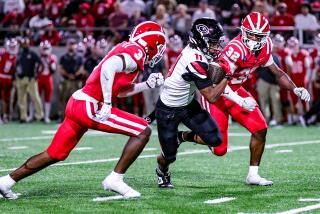True Tight Ends Are Hard to Find : Football: Because of changing offenses and decreasing size of talent pool, the position has become obsolete at many county high schools.
High school football offenses, ever changing, roll along in the 1990s. Coaches tinker and adapt, making the best of the personnel at hand. What works one season doesn’t the next; hence the ever-evolving state of the game.
Consider the not-so-mysterious case of the disappearing tight end. It’s happening all over the game--in the NFL (especially the NFL), in college and on high school teams around Orange County.
The traditional version of the tight end--a sturdy, solidly built player who lines up next to an offensive tackle and is half-blocker and half-receiver--has become increasingly difficult to find. For that reason, the position is now obsolete at many schools.
Some coaches make do with a tight end who is little more than a glorified offensive lineman and rewrite the playbook lest they be forced to call on him to make an important catch. Others employ a wide receiver and hope he can throw an occasional block without losing a limb.
Los Alamitos hasn’t bothered to put a player at tight end since 1984. Capistrano Valley once went without one for nearly a decade but has a good one now. Blessed with fine talent at all positions since it opened in 1969, Edison has never lacked for a quality tight end. Still, some years are better than others for the Chargers, and this happens to be a good year.
This is not to suggest that the position will disappear forever. Coaches who have been around the block say it is in a down cycle. Some day, tight ends will make a comeback. But today, no matter how hard you look, a good tight end is difficult to find.
Why?
For the answers, start at the top with Ram offensive coordinator Ernie Zampese, who said there has been an appalling lack of qualified tight ends in recent NFL drafts.
“You don’t see the Kellen Winslows, the John Mackeys, those kinds of guys,” said Zampese, who coached Winslow when both were with the San Diego Chargers. “I think those were the prototype tight ends, big guys who could run, who could catch. They could do everything.
“Maybe they’re Lawrence Taylor now. Carl Banks. Those types of guys. Maybe they’re the big, big linebackers who are in the game today. Maybe that’s who they are. Maybe they’re playing those positions.”
Gene Murphy, Cal State Fullerton’s coach, also finds it difficult to uncover quality tight ends when he hits the recruiting trail.
“We’re playing with medium-sized guys who are almost fullbacks,” Murphy said. “We’re definitely out there looking for tight ends. It’s a cycle. If the NFL said we’re going to run 60-yard dashes (instead of 40), then we would, and then the high schools would.”
Nowhere is the supply of tight ends smaller than at the high school level.
Even if Los Alamitos Coach John Barnes hadn’t embraced the new wave of passing offenses in the early 1980s, he might still have phased out the position because he had trouble finding someone talented and big enough to play it. And now that the Griffins have switched to a run-and-shoot, there simply isn’t room for a traditional tight end, what with four wide receivers on the field at once.
“There’s no such thing anymore,” Barnes said. “You know the traditional tight end, half-lineman, half-receiver? Well, he’s all receiver now.”
Blake Spence, a 6-foot-4, 215-pound junior at Capistrano Valley, plays tight end the way they used to define the position, but he wishes the coaching staff would make more use of him as a receiver; he has only six catches for 107 yards. Blocking, he has learned, is tedious. Catching passes is more fun.
Spence was a freshman tailback when the Cougar coaches asked him to switch to tight end for his sophomore season. He agreed when it became apparent he would have little competition for a starting spot on the varsity.
“We haven’t had a tight end like (Spence) since 1980,” said Eric Patton, Capistrano Valley’s coach. “He’s a good one, a blue-chip Division I prospect. He’s really a big part of the offense.”
So big, in fact, that when Spence was sidelined with an injured shoulder for two games this season, it took six players to replace him.
“They got guys from the defense to block on running plays, and on pass plays they got other receivers to play there,” Spence said. “That made me feel like I was more important to the team.”
Adrian Ioja, a 6-3, 228-pound senior at Garden Grove, is another tight end who finds little competition for his job.
“I was at a scouting combine this summer, and when we broke into groups, there were only six tight ends,” Ioja said. “Most of them were really linemen. So maybe the position is dying out.”
At Edison, it is too important in the Chargers’ method of operation to let it completely disappear from the playbook.
“First, we take a kid who is a great receiver,” Edison Coach Dave White said. “We want a guy who can catch. You get a guy who’s a great athlete, then teach him to block.”
Over the years, Edison has produced such standouts as Vic Rakhshani, who played at USC and with the Rams, and Mark Boyer (USC, the Indianapolis Colts and New York Jets). The latest to fill the position is Rod Lippincott, a 6-2, 210-pound senior who has 21 catches for 214 yards.
“Rod’s a good athlete with good hands, and he’s tough,” White said. “If you have those three things at our school, you’re going to be pretty successful.”
In the past, when Edison didn’t have someone good enough, they made subtle offensive changes.
“We wouldn’t throw it to him,” White said. “We’d block more. We’d take him out and put another wide receiver in the game (in passing situations). You have to adjust. If you don’t, you’re crazy.”
So where do coaches go to find candidates for tight end? Would you believe the basketball court?
“I think all the best skill players are basketball players,” White said. “Michael Jordan would be a great wide receiver in the NFL.”
Patton agrees.
“There are probably a lot of basketball players who would make great tight ends,” he said. “But it’s one of the effects of kids playing only one sport. One of the problems of finding the prototype tight end is that he’s playing basketball. Scott McCorkle would have been a great tight end.”
McCorkle, a 6-5 former Times Orange County Edition all-county forward, choose basketball over football and now plays at Syracuse. Spence, a power forward for the Cougars, decided to play both sports. So did Lippincott.
Moreover, specialization within football also has taken a toll on the tight end position, according to Zampese.
“It’s all a role game now,” he said. “It’s turned into a substitution game. It started quite awhile ago, really.”
That doesn’t mean the Rams wouldn’t adjust their offense to include a traditional tight end if one became available, does it?
“If we could find one we could sure use him, I’ll tell you,” Zampese said. “It would be great to have a Kellen Winslow. He could play every down.”
Murphy said the trend toward passing offenses that started in the NFL many years ago and then moved to the colleges, has now taken root in the high schools, accounting for further movement away from tight ends.
“If you go back 10 years ago, three wide receivers were probably all they had on the whole team,” Murphy said. “Now, they have three on the field at once.”
But it might change again soon, Murphy said.
“It’s like that Seagram’s ad where the guy has the 1962 haircut. His hairstyle changes until it’s the present and the guy has the same haircut again. It happens a lot in football. The double tight end offense is coming back. So who knows? Tight ends might make a comeback.”
But leave it to a tight end to say it best.
“Coaches will always need someone to make that third-down catch over the middle,” Ioja said. “So I think there always will be a place for tight ends.”
Fading Out
As high school offenses have evolved, the tight end--a combination blocker and receiver who lines up “tight” against a tackle--has given way to players who line up wider and are primarily pass-catchers. The evolution at Los Alamitos: 1980 Pro Set: Eleven years ago, the Griffins used a tight end in the traditional sense. 1985 Slot Split: Five years later, he was lining up wider and was more a receiver than a blocker. 1991 Run and Shoot: Today, he plays anything but ‘tight’, lining up outside as one of four receivers.
Source: Los Alamitos High
More to Read
Get our high school sports newsletter
Prep Rally is devoted to the SoCal high school sports experience, bringing you scores, stories and a behind-the-scenes look at what makes prep sports so popular.
You may occasionally receive promotional content from the Los Angeles Times.






